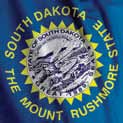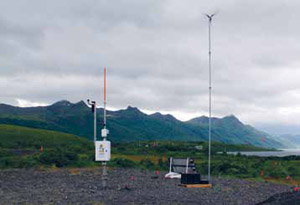South Dakota Purchases Weather Systems for General Aviation Airports
 With traffic from air ambulances, game hunters, corporate executives and local fliers, South Dakota's general aviation (GA) airfields serve a wide variety of pilots; and state officials recognize the benefit of providing them with current weather information as they fly in and out.
With traffic from air ambulances, game hunters, corporate executives and local fliers, South Dakota's general aviation (GA) airfields serve a wide variety of pilots; and state officials recognize the benefit of providing them with current weather information as they fly in and out.

"These general aviation airports are a real necessity to the communities out here," says Jim Bonebright, manager of Miller Municipal Airport in Miller, SD.
Agreeing with Bonebright's sentiment and understanding that GA airports don't have the funds to purchase weather systems themselves, the state of South Dakota began installing SUPERAWOS (Automated Weather Operating Systems) in many of its small- to medium-sized airports four years ago.
Why They're SUPER
By installing the equipment, the state provides pilots at GA airfields with weather information akin to what's routinely available at large commercial airports. Each SUPERAWOS costs the state about $75,000; each airport pays a few hundred dollars per year to maintain its own system, reports John Becker, aeronautics project engineer with the South Dakota Department of Transportation. In contrast, a standard AWOS costs $150,000 to $200,000, plus $5,000 to $7,000 per quarter to maintain. "It's a burden that your small airports are not normally going to take on," Becker relates.
|
factsfigures Project: Weather Reporting Service Location: 20 GA Airports in South Dakota Equipment: SUPERAWOS Manufacturer: Potomac Aviation Technology Corp. Cost: $75,000/unit Funding: State of South Dakota Maintenance Expenses: $100-$300/year Available to Pilots: 24/7 Expansion: 9 additional airports scheduled to receive units this summer. |
With the state paying for SUPERAWOS equipment, municipalities are more than willing to take on maintenance costs for the amount of capability they receive from the device, he adds.
SUPERAWOS, manufactured and monitored 24/7 by Potomac Aviation Technology Corp., provides pilots with real-time information needed for operational decisions. Readings include weather basics such as wind speed and direction, as well as other information including altitude and traffic advisories.
"It's like having a human Unicom operate on the frequency providing all the services pilots need," describes David Wartofsky, founder of Potomac Aviation. As owner of Potomac Airfield in Maryland, the company understood what an airport and its users actually need, Wartofsky explains.
frequency providing all the services pilots need," describes David Wartofsky, founder of Potomac Aviation. As owner of Potomac Airfield in Maryland, the company understood what an airport and its users actually need, Wartofsky explains.
The readings are "advisory," he adds, meaning the system recognizes when certain measurements are unnecessary and suppresses them. It also "listens" and adapts to how the frequency is being used - transmitting only when the frequency is clear and using low power so aircraft transmissions can be heard over it. Additionally, users on the ground and in the air can hear SUPERAWOS reports from XM Satellite Radio's "Weather in the Cockpit" channel.
It meets FAA requirements for not requiring a ceiling, as an altimeter-setting source and source of visibility.
Welcome Development
Bonebright first learned about SUPERAWOS at industry conferences. He researched its capabilities and benefits, even though the system was out of Miller Municipal's price range. His persistent interest in the system, however, led the state to find him when it initiated its SUPERAWOS project. The idea was music to Bonebright's ears.
SUPERAWOS, he explains, is a perfect fit for Miller Municipal - a small GA airport that provides "huge benefits" to its 1,300-person town and surrounding area. The airport's 3,600-foot asphalt runway supports spray planes for local farmers, facilitates air ambulance service to Miller's hospital from remote areas and provides service to regional corporate flight departments and pheasant hunters from all over the nation. The SUPERAWOS "gives us the opportunity to have real-time weather readings right on the airfield," he explains. "I'm just tickled we got one."
According to Bonebright, upkeep on the device is simple: A quick phone call to the company has resolved any issues he has encountered.
The unit also includes a self-diagnostic system. "If that doesn't work, we FedEx a new module to the airport and anyone can go out and change it," explains Gary Loff, senior vice president of sales for Potomac Aviation.
"It's simple," says Loff, noting that a veterinarian installed a unit at one South Dakota airport. "It can be operational the same day it arrives, operating off solar energy. It's completely wireless and green. You don't have to dig up your airport to run electricity."
 Bonebright recently completed a system upgrade at Miller Municipal by installing a disk and letting it run through the program. "Everything is hands-on and easy," Bonebright reports.
Bonebright recently completed a system upgrade at Miller Municipal by installing a disk and letting it run through the program. "Everything is hands-on and easy," Bonebright reports.
The SUPERAWOS battery is connected to the windsock light circuit at the airport. The unit charges at night and runs on battery power during the day if the lights are off. When a landing necessitates lighting, the unit automatically switches into charging mode.
Pilots say they appreciate the ease-of-use the SUPERAWOS provides. A quick radio check provides up-to-the-minute advisories with a few clicks of the aircraft mic.
"It's a real good deal for an airport that doesn't have the kind of money to have a bigger unit," Bonebright explains.
ROI at Sturgis
Reviews from Sturgis Municipal Airport are similarly glowing. After two years using the service, operators continue to rave about its capabilities and positive return on the state's investment.
"SUPERAWOS is very helpful to pilots - especially after-hours, when we're not there to answer the Unicom," remarks airport manager Jerry Burnham. "They can access it themselves, 24/7."
After reading articles on the SUPERAWOS product, he proposed a cost-sharing arrangement to state officials years ago. Without FAA approval for the system, however, the state wasn't willing to fund the equipment. But when approval was issued, officials decided to fund the weather stations in full, and Sturgis Municipal was at the top of the list to receive a unit.
South Dakota, Burnham explains, is supportive with airport funds. "They want to save operations and like to keep the air traffic counts up," he explains.
Burnham pegs maintenance costs for the unit between $200 and $300 per year. "We just have to keep the altimeter calibrated on a monthly basis and change the batteries - minor stuff," he notes. "We couldn't afford to go with the traditional AWOS system because the maintenance and upkeep are so high. We couldn't justify it."
One other expense at Sturgis Municipal was the addition of a satellite system, because the remote area didn't previously have high-speed Internet service. "The city was happy and willing to sign the grant agreement to maintain it," Burnham recalls. "It's a great improvement for the airport."
The improvement, however, catches some pilots by surprise. "They're not always familiar with the SUPERAWOS, so when it answers them when they call in, it's a shock," he notes.
Pilots who use the airport regularly have become familiar with the system and appreciate its increased capabilities.
The 5,100-foot concrete runway at Sturgis Municipal services a variety of traffic, including visitors to the Veterans' Administration hospital. Since the addition of the SUPERAWOS, charter flights can also legally land IFR there.
While the airport houses just 35 aircraft year-round, an influx of traffic arrives each summer for the annual Sturgis Motorcycle Rally. "That week alone we'll have 150 to 200 aircraft operations here," reports Burnham.
With so many aircraft landing at the small municipal airport, real-time weather information enhances safety and ease of operations. "It's a big improvement for the whole state," he relates.
More to Come
With 20 SUPERAWOS systems already in operation, nine additional South Dakota communities are scheduled to receive state-provided units this summer: Martin, Bison, Canton, De Smet, Faulkton, Flandreau, Highmore, Platte and Sisseton.
Airports outside South Dakota can also defray the cost of purchasing a SUPERAWOS unit, relates Wartofsky, noting that the equipment is eligible for Airport Improvement Program (AIP) funding. Emergency locator transmitter detection may also be included in the bid, he adds.
2022 Charlotte Douglas International Airport Report of Achievement
 Giving back to the community is central to what Charlotte Douglas International Airport and its operator, the City of Charlotte Aviation Department, is about, and last year was no different.
Giving back to the community is central to what Charlotte Douglas International Airport and its operator, the City of Charlotte Aviation Department, is about, and last year was no different.
Throughout 2022, while recovering from the COVID-19 pandemic, we continued our efforts to have a positive impact on the Charlotte community. Of particular note, we spent the year sharing stories of how Connections Don't Just Happen at the Terminal - from creating homeownership and employment opportunities to supporting economic growth through small-business development and offering outreach programs to help residents understand the Airport better.
This whitepaper highlights the construction projects, initiatives, programs and events that validate Charlotte Douglas as a premier airport.
Download the whitepaper: 2022 Charlotte Douglas International Airport Report of Achievement.








